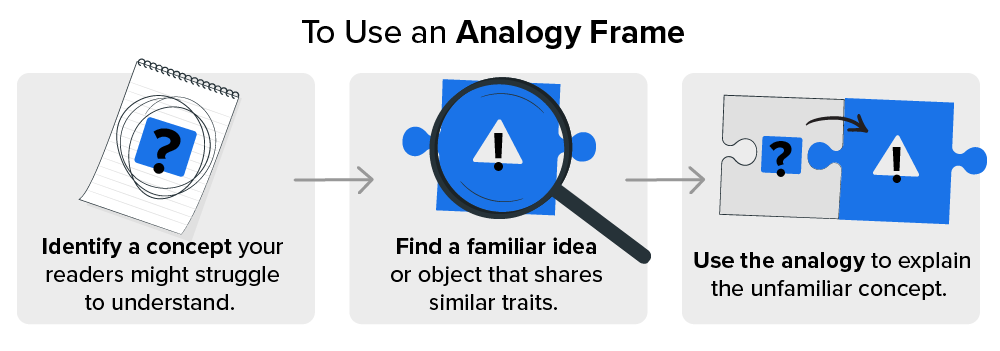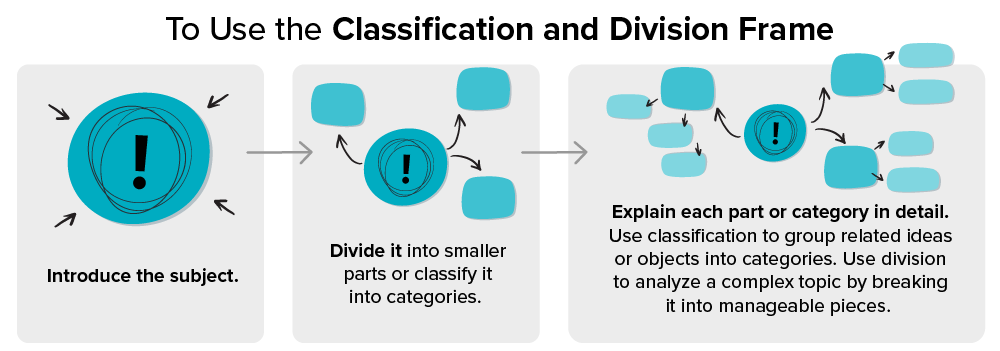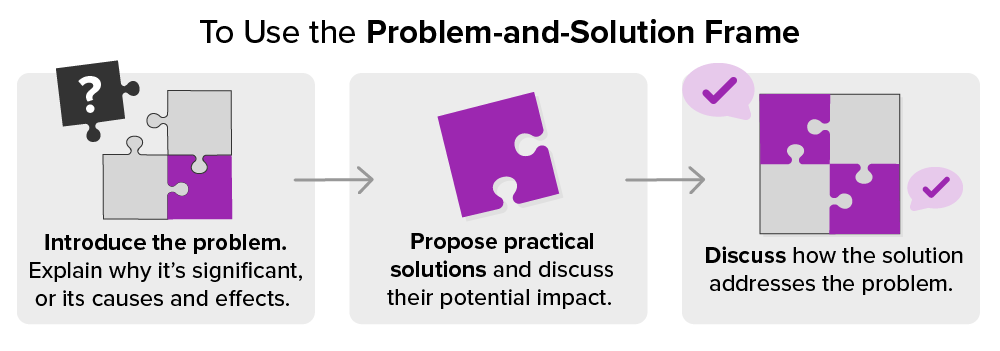In this lesson, you will explore several key analytic strategies and practice deploying them in your own draft. Specifically, this lesson will cover:
1. Analytical Strategies
Analysis is more than just your evaluation of sources. Analysis is a key way you can help your readers understand your perspective. One of the best ways to do this is by incorporating analytical strategies into your writing. There are a fairly endless number of ways to categorize analysis. Scholars write books arguing about the right ways to categorize analysis.
But there are some very clear ways you can show your reader that you are doing the work of analysis. Let’s focus on a few main strategies. These strategies are tools that can help you break down complex ideas, make connections, and guide your readers through your arguments. We’ll just introduce these here, but you can use them to evaluate sources really impactfully. You might find that showing how the analogy in a source isn’t accurate is a great way to show that you have a strong argument. You can show how a source has the wrong cause for an effect or show that a source has the wrong definition or classification strategy.
You will probably do some of these strategies naturally, without naming them for your reader. That is fine. But sometimes it can be nice to tell your reader what you are about to do. These terms can, in that way, help you write good transitions!
Once you have determined your reasoning strategy and purpose for a particular paragraph, consider how to develop the evidence within that paragraph through a topic sentence, explanation, and analysis. To help you do this, we will review a few frames you can use:
- Analogy
- Cause and Effect
- Classification and Division
- Compare and Contrast
- Problem and Solution
- Definition
Let’s look closer at these different paragraph frames. As we work through these strategies, think about the source or the paragraphs where you can try out what you are learning.
1a. Analogy: Making the Unfamiliar Familiar

An analogy compares something unfamiliar to something familiar to help your readers understand it better. Think of it as saying, “This new concept is like something you already know.” Analogy paragraphs often begin with a statement of comparison between two unlike subjects, followed by reasons, explanations, or analyses of their similarities. Select the expandables below to see some examples.
Analogy topic sentences___________ is like ___________ in many ways.
Example: Enrolling as a first-year college student is like visiting an amusement park for the first time in this way: The inexperienced students and park-goers must pay a high fee, abide by strict rules, and choose how they spend their adventure.
Example analogy paragraph
Topic: Compare enrolling as a first-year college student to visiting an amusement park for the first time.
Paragraph: Enrolling as a first-year college student is like going to an amusement park for the first time: The inexperienced students or park-goers must pay a high fee, abide by many rules, and choose their adventures. Like the cost for riding roller coasters, the cost for taking college classes is great and must be paid before the students start their journey. However, even after paying tuition, students do not have immediate access to whatever class they want to take, just as the park visitor cannot jump on any ride at any time. In the park, certain rides have warnings, such as “you must be at least 60 inches tall to go on this ride.” In college, many classes have prerequisites or require students to have earned a minimum placement score. Also, even though park-goers have paid their entrance fees and received armbands that allow them to go anywhere in the park, they are not guaranteed a place on that one awesome ride they have heard so much about. They may have to choose between waiting in a line for hours or doing something else and trying to catch that ride another time. Similarly, college classes have a limited number of seats. Like the roller coaster that everyone wants to ride, college classes close, and students must make another choice. So, while students may not be able to pick up that class that semester, they can try again the next term. Like those starting an adventure at an amusement park, those starting the college journey should have a plan of how they want to fill their time and have a backup plan should they be unable to get every class they want, according to Max Vega, a first-year adviser. Similarly, park-goers should use a map to plan their adventure.
Signal words and phrases to use with the analogy paragraph frame
- accordingly
- for instance
- in relation to
- given that
- in the same way (that)
- as noted
- granted that
- in this way
- having established that
- as previously mentioned
- in addition
- paradoxically
- in contrast
- similarly
- by extension
- in fact
- specifically
- compared with
- for example
- in particular
- thus
- Analogy
- Explains to readers a subject with which they are unfamiliar by comparing a specific trait or traits with those of a more familiar subject.
1b. Cause and Effect: Connecting Events and Outcomes

The cause-and-effect approach explores the relationship between events, explaining why something happened and what resulted from it. Paragraphs explaining cause and effect usually begin with the causes first and then the effects. However, if the cause is a surprise, it can be worth leading with the effect. Otherwise, most authors start with causes. Select the expandables below to see some examples.
Cause-and-effect topic sentence
- Because (cause) ___________ (what had happened), (effect) ___________ (what happened as a result).
- Some might find it strange that the (effect) ___________ (what happened as a result) because (cause) ___________ (what had happened).
Example: Because an oil spill occurred off the coast of California, the fur and feathers of animals became dangerously matted, waterways were damaged, and the cost of maintaining a clean environment skyrocketed.
Example cause-and-effect paragraph
Topic: How an oil spill affected animals, waterways, and environmental costs.
Paragraph: Because an oil spill occurred off the coast of California, the fur and feathers of many animals became dangerously matted, waterways were damaged, and the cost of maintaining a clean environment skyrocketed. In May 2015, a ruptured pipeline in Santa Barbara County spilled oil along 20 miles of coastline. According to information published by the University of California-Davis, wildlife rescuers were able to save 49 coastal birds, 25 sea lions, and six elephant seals (Kerlin, “Wildlife Experience High Price of Oil”). Helping ecosystems recover from oil spills is difficult and can take decades and billions of dollars to recover even partially.
- Cause-and-Effect Approach
- Provides a clear understanding of the relationship between an event or situation and/or what happened because of it, why it occurred, and what might continue to happen.
1c. Classification and Division: Breaking It Down

The classification-and-division approach involves breaking a subject into smaller parts (division) or grouping similar elements together (classification) to make it easier to understand. Select the expandables below to see some examples.
Classification-and-division topic sentence
Classification-and-division paragraphs often begin in either of two ways:
- Classification paragraphs identify individual items and place them in a larger group: (smaller category) ___________, ___________, and ___________ are (types) of (larger subject)___________.
- Division paragraphs break a large group or a single unit into smaller parts: (general subject) ___________ can be divided into (smaller categories) ___________, ___________, and ___________.
Example: The layout for the new superstore will be divided into furniture (third floor), household goods and kitchenware (second floor), and men’s, women’s, and children’s clothing (first floor).
Example classification-and-division paragraph
Topic: How the new superstore will be divided.
Paragraph: The layout for the new superstore can be divided into furniture (third floor), household goods and kitchenware (second floor), and men’s, women’s, and children’s clothing (first floor). This arrangement allows customers to feel they have control over their shopping experience. Customers shopping for clothes are not distracted by household goods or furniture displays. “By categorizing our merchandise in this manner, we can further subdivide the merchandise on each floor, developing a logical system of separation that repeat customers will learn easily,” said Carla Dawkins, general manager for Hometown Corner Store, in a Curtisville News report (Thurston 2). These subdivisions, Thurston stated, would allow individual floor managers to design the footprint of their floors to create an originality distinct and separate from the other floors (8).
- Classification-and-Division Approach
- Explains a subject by breaking it into smaller parts and explaining the distinctions of the smaller parts or by grouping individual, disparate elements on the basis of certain characteristics to form larger units.
1d. Compare and Contrast: Highlighting Similarities and Differences

The compare-and-contrast strategy examines the similarities or differences between two or more subjects to make a point. Select the expandables below to see some examples.
Compare-and-contrast topic sentenceWhen using compare-and-contrast reasoning, you have choices about the structure to use:
- Identify two subjects and address their similarities and then their differences: One way in which (subject 1) ___________ and (subject 2) ___________ are alike is (similarity) ___________; one way in which they differ is (difference) ___________.
- Identify two subjects and address their differences and then their similarities: One way in which (subject 1) ___________ and (subject 2) ___________ are different is (difference) ___________; one way in which they are similar is (similarity) ___________.
Example: Immunotherapy and chemotherapy are alike in that both are used to treat cancer; however, they differ in their mechanisms, with immunotherapy harnessing the body's immune system to fight cancer cells, while chemotherapy uses drugs to kill rapidly dividing cancer cells directly.
Example compare-and-contrast paragraph
Topic: Immunotherapy and chemotherapy.
Paragraph: Different approaches to treating cancer, such as surgery, chemotherapy, radiation therapy, and immunotherapy, vary significantly in their methods and applications, yet often complement one another in treatment plans. Surgery involves the physical removal of tumors and is most effective for localized cancers, whereas chemotherapy uses drugs to target rapidly dividing cells and is often employed for cancers that have spread. Radiation therapy, like surgery, is localized but uses high-energy radiation to destroy cancer cells. In contrast, immunotherapy harnesses the body's immune system to identify and fight cancer cells, offering a more systemic and targeted approach. While traditional methods like surgery and radiation can have immediate results in reducing tumor size, they may also damage surrounding healthy tissue. Chemotherapy and immunotherapy, on the other hand, are systemic treatments that can address widespread cancer, but chemotherapy often causes significant side effects due to its impact on healthy cells, whereas immunotherapy may be more precise but is not universally effective. These treatments can be used independently or in combination, depending on the type, stage, and aggressiveness of the cancer, highlighting the need for personalized treatment strategies.
Signal words and phrases to use with comparisons
- alike
- compared with
- same (as)
- along the same lines
- in comparison
- share
- as well as
- in like manner
- similar(ly)
- both
- in the same way
- similar (to)
- each
- the same as
- equal(ly)
- just as
- in common
- likewise
Signal words and phrases to use with contrasts
- although
- but
- by (in) contrast
- different (from)
- as opposed to
- compared with
- either/or
- conversely
- even though
- however
- on the contrary
- yet
- instead (of)
- on the other hand
- so (that)
- more/less than
- therefore
- neither/nor
- vary
- nevertheless
- whereas
- Compare-and-Contrast Strategy
- Examines the similarities and/or differences of subjects in order to explain a specific point about their similarity or difference (often an unexpected similarity or difference).
1e. Problem and Solution: Addressing Challenges

The problem-and-solution strategy identifies a problem and proposes one or more solutions to address it. Most problem-and-solution paragraphs begin with the problem, but if the solution is unique enough, you might begin with the solution. Select the expandables below to see some examples.
Problem-and-solution topic sentence
- The issue of (predicament or challenge) _____________________ was/can be solved by (what was/should be done) _____________________.
- By (what was/should be done) _____________________, the issue of (predicament/challenge) _____________________ was/could be solved.
Example: By paving the area on the corner of Twelfth and Locust Streets to allow parking on that lot, the issue of the increased need for parking on campus would be solved, an eyesore would be beautified, and more students and faculty would get to class on time.
Example problem-and-solution paragraph
Topic: Campus parking.
Paragraph: The issue of the increased need for parking on campus would be solved by paving the area on the corner of Twelfth and Locust Streets to allow parking on that lot. According to an email sent to all students from the provost, Dr. Sandra Kuryakin, the college purchased the corner lot 2 years ago with the intent of creating more parking spaces. In the email, Dr. Kuryakin adds, “We will break ground in June and plan to have the lot finished before students are back on campus in August, thus solving our parking problem on the west end of campus.”
Signal words and phrases to use with solutions
- a (one) solution
- cure
- one answer is
- address
- deal with
- option
- alleviate
- ease
- possibility
- explain/explanation
- probability
- fix
- propose
- answer
- improve
- proposition
- correct
- prospect
- reason
- solution
- treat(ment)
- solve
- way out
- resolution (resolve)
- Problem-and-Solution Strategy
- Indicates a predicament or difficulty and suggests ways to deal with or eliminate it.
1f. Definition: Explaining What You Mean

Definition involves explaining the meaning of a term, concept, or idea, often by providing details and examples. Use this strategy when your readers might not be familiar with a term or when you want to explore a concept in depth. Provide examples, context, and analysis to clarify the definition. Definition paragraphs often begin by noting a common understanding of the topic and then illustrating and explaining a unique or extended meaning. Select the expandables below to see some examples.
Definition topic sentence
- Most people think ______________ means ______________; to me, however, ______________ means ______________.
Topic Sentence: Most people think patriotism is showing devotion to their country; to me, however, it is conducting myself in ways that are respectful to everyone.
Example definition paragraph frame
Topic: Patriotism.
Paragraph: Most people think patriotism means showing devotion to their country; to me, however, it is conducting myself in ways that are respectful to everyone. Too often, people proclaim themselves as patriots when they are actively seeking to withhold liberties from their fellow citizens or even harm them. When those claiming to be patriots condemn and physically harm others because they do not agree on political issues, they are not showing any reverence for their country. Instead, they dishonor their country by dishonoring its people. Respecting America should mean more than saluting the flag or singing the national anthem. It should mean respecting others’ rights to life, liberty, and the pursuit of happiness. In light of all this, for me, patriotism means respecting others not only because they are fellow Americans but also because they are fellow human beings.
In the touchstones for this unit, you will have a chance to use these analysis frames (or strategies) we discuss in this tutorial. As you are working with analysis frames, remember that you are looking to show your reader just how deeply you can read and analyze a source. Put in lots of signposts and signals for your reader to follow, like “for example,”” on the contrary,” or “the problem with this example.” Also, look to avoid quick analysis that just says that you are right. You want to spend some time showing you are right. Use quotes and paraphrases from the source so that you can go into detail about what you think the source got right or wrong.
- Definition
- Illustrates to readers an idea, word, or expression, allowing you to explain a unique meaning of a topic through details and analysis.
This lesson introduced analytical strategies for building your case, and each offers a different way to break down complex ideas and support persuasive arguments. Using analogy involves making the unfamiliar familiar, explaining unfamiliar concepts by comparing them to familiar experiences, while cause and effect connects events and outcomes, showing how one event leads to another, establishing logical relationships. The classification-and-division strategy organizes information by sorting subjects into categories or taking a whole and breaking it down into parts, making topics more manageable. Writers can also apply a compare-and-contrast strategy to highlight similarities and differences between ideas, offering nuanced insights. The problem-and-solution approach identifies and addresses challenges and explores potential remedies, promoting thoughtful argumentation. Finally, definition involves explaining what you mean, allowing writers to clarify terms or concepts that might be misunderstood or carry different meanings. Together, these strategies serve as foundational tools for analyzing texts, constructing coherent arguments, and guiding readers through complex reasoning.





